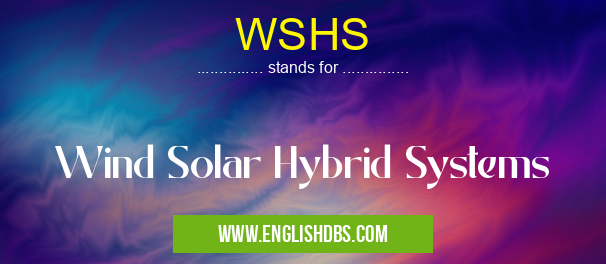What does WSHS mean in UNCLASSIFIED
WSHS stands for Wind Solar Hybrid Systems. These systems combine wind turbines and solar panels to generate electricity, providing a reliable and sustainable energy source. By utilizing both renewable energy sources, WSHS can reduce dependency on fossil fuels and minimize environmental impact.

WSHS meaning in Unclassified in Miscellaneous
WSHS mostly used in an acronym Unclassified in Category Miscellaneous that means Wind Solar Hybrid Systems
Shorthand: WSHS,
Full Form: Wind Solar Hybrid Systems
For more information of "Wind Solar Hybrid Systems", see the section below.
Components of WSHS
- Wind Turbines: Convert wind energy into electrical energy.
- Solar Panels: Convert sunlight into electrical energy.
- Batteries: Store excess electricity generated during peak production periods.
- Power Conditioning Unit: Converts the generated electricity into usable AC power.
- Controller: Monitors and optimizes the system's performance.
Advantages of WSHS
- Reliable Energy Supply: Combine wind and solar power to ensure a steady flow of electricity, even during fluctuations in weather conditions.
- Environmental Sustainability: Utilize renewable energy sources, reducing carbon emissions and promoting a cleaner environment.
- Energy Independence: Reduce reliance on external energy sources and increase energy self-sufficiency.
- Cost Savings: Long-term energy cost savings by utilizing free and abundant natural resources.
- Versatility: Suitable for both residential and commercial applications, providing a customized energy solution.
Applications of WSHS
- Off-grid electricity generation in remote areas
- Supplementing grid power during peak demand
- Providing backup power during outages
- Residential and commercial buildings
- Agricultural and industrial facilities
Essential Questions and Answers on Wind Solar Hybrid Systems in "MISCELLANEOUS»UNFILED"
What are Wind Solar Hybrid Systems (WSHS)?
WSHS are standalone power systems that combine wind turbines and solar panels to generate electricity. They are designed to provide a reliable and sustainable energy source for remote locations or areas with limited grid access.
How do WSHS work?
WSHS utilize both wind and sunlight to generate electricity. The wind turbine converts the kinetic energy of the wind into electrical energy, while the solar panels convert solar energy into electrical energy. The electricity generated is stored in batteries for later use.
What are the benefits of using WSHS?
WSHS offer several benefits, including:
- Reliability: They provide a continuous and stable power supply, as they can rely on both wind and solar resources.
- Sustainability: They generate renewable energy, reducing reliance on fossil fuels and minimizing environmental impact.
- Cost-effectiveness: They can be more economical compared to traditional grid-powered systems in remote areas.
What are the limitations of WSHS?
WSHS have certain limitations to consider:
- Intermittency: Wind and solar power are intermittent sources, so power output can vary depending on weather conditions.
- Installation cost: Initial installation costs for WSHS can be substantial.
- Battery storage: Battery storage capacity limits the amount of electricity that can be stored for later use.
Where are WSHS typically used?
WSHS are commonly used in remote areas, such as:
- Off-grid homes and cabins
- Remote industrial facilities
- Telecommunication towers
- Water pumping systems
Final Words: WSHS offer a comprehensive and sustainable solution for electricity generation. By combining wind and solar power, these systems provide a reliable, environmentally friendly, and cost-effective alternative to traditional energy sources. As the demand for renewable energy grows, WSHS are poised to play a significant role in shaping a greener and more energy-secure future.
WSHS also stands for: |
|
| All stands for WSHS |
